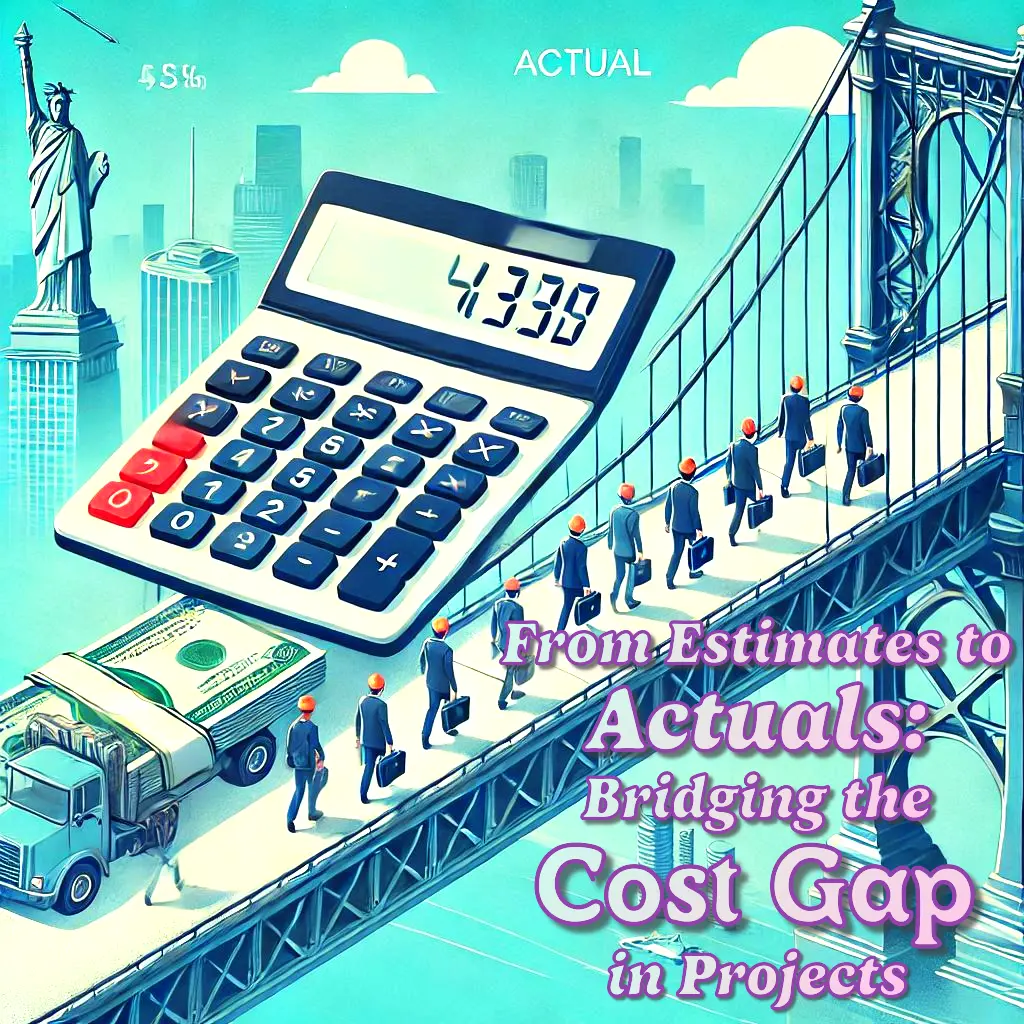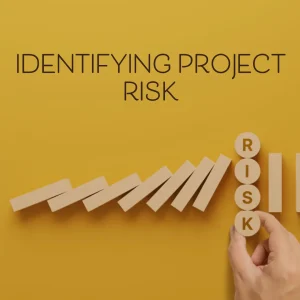Introduction
In the realm of project management, the financial aspect is often a critical determinant of success. Understanding the distinction between estimated costs and actual costs is fundamental for project managers and estimators alike.
- Estimated Costs refer to the projected expenses that are anticipated for a project based on initial planning and resource allocation. These estimates are crucial for budgeting and securing project approval, as they provide stakeholders with a forecast of the financial commitment required. Conversely, Actual Costs represent the real expenses incurred during the execution of the project. This includes all expenditures related to labor, materials, overhead, and any unforeseen costs that may arise throughout the project lifecycle.
- The significance of understanding and managing the cost gap— the difference between estimated and actual costs—cannot be overstated. Discrepancies between these two figures can lead to financial challenges, project delays, and even project failure. By closely monitoring this gap, project managers can identify areas where costs are exceeding estimates and take corrective actions to mitigate risks. This proactive approach is essential for maintaining project viability and ensuring that resources are utilized efficiently.
- Bridging the gap between estimated and actual costs is vital for project success. It not only enhances the accuracy of future cost estimations but also builds trust with stakeholders by demonstrating a commitment to financial accountability. Effective cost management practices, such as regular performance measurement and reconciliation of estimates, empower project teams to make informed decisions, adjust budgets as necessary, and ultimately deliver projects on time and within budget. By prioritizing the alignment of estimated and actual costs, project managers can foster a culture of transparency and continuous improvement, setting the stage for successful project outcomes.
Estimated Costs refer to the projected expenses that are anticipated for a project based on initial planning and resource allocation. These estimates are crucial for budgeting and securing project approval, as they provide stakeholders with a forecast of the financial commitment required. Conversely, Actual Costs represent the real expenses incurred during the execution of the project. This includes all expenditures related to labor, materials, overhead, and any unforeseen costs that may arise throughout the project lifecycle.
The significance of understanding and managing the cost gap— the difference between estimated and actual costs—cannot be overstated. Discrepancies between these two figures can lead to financial challenges, project delays, and even project failure. By closely monitoring this gap, project managers can identify areas where costs are exceeding estimates and take corrective actions to mitigate risks. This proactive approach is essential for maintaining project viability and ensuring that resources are utilized efficiently.
Bridging the gap between estimated and actual costs is vital for project success. It not only enhances the accuracy of future cost estimations but also builds trust with stakeholders by demonstrating a commitment to financial accountability. Effective cost management practices, such as regular performance measurement and reconciliation of estimates, empower project teams to make informed decisions, adjust budgets as necessary, and ultimately deliver projects on time and within budget. By prioritizing the alignment of estimated and actual costs, project managers can foster a culture of transparency and continuous improvement, setting the stage for successful project outcomes.
In the following sections, we will explore best practices for transitioning from estimated costs to actual costs, equipping project managers and estimators with the tools needed to navigate this critical aspect of project management effectively.
Understanding the Cost Estimation Process
In project management, transitioning from estimated costs to actual costs is a critical aspect that can significantly impact the success of a project. Understanding how cost estimates are developed is essential for project managers and estimators. Here are some key points to consider:
Different Methods of Cost Estimation
- Analogous Estimating: This method involves using the costs of previous, similar projects as a basis for estimating the costs of the current project. It is a quick and less resource-intensive approach but may lack precision if the previous projects differ significantly from the current one.
- Parametric Estimating: This technique uses statistical relationships between historical data and other variables to calculate cost estimates. For example, if historical data shows that a certain type of project costs $10,000 per unit, this rate can be applied to the current project based on the number of units required.
- Top-Down Estimating: In this approach, the overall project cost is estimated first, and then it is broken down into smaller components. This method is useful for high-level budgeting but can overlook specific details that may lead to inaccuracies.
- Bottom-Up Estimating: This method involves estimating the costs of individual tasks or components and then aggregating them to arrive at the total project cost. While this approach is more time-consuming, it often results in more accurate estimates as it considers the specifics of each task.
Analogous Estimating: This method involves using the costs of previous, similar projects as a basis for estimating the costs of the current project. It is a quick and less resource-intensive approach but may lack precision if the previous projects differ significantly from the current one.
Parametric Estimating: This technique uses statistical relationships between historical data and other variables to calculate cost estimates. For example, if historical data shows that a certain type of project costs $10,000 per unit, this rate can be applied to the current project based on the number of units required.
Top-Down Estimating: In this approach, the overall project cost is estimated first, and then it is broken down into smaller components. This method is useful for high-level budgeting but can overlook specific details that may lead to inaccuracies.
Bottom-Up Estimating: This method involves estimating the costs of individual tasks or components and then aggregating them to arrive at the total project cost. While this approach is more time-consuming, it often results in more accurate estimates as it considers the specifics of each task.
Common Challenges in Creating Accurate Cost Estimates
Creating accurate cost estimates is fraught with challenges, including:
- Inadequate Scope Definition: A poorly defined project scope can lead to misunderstandings about what is included in the project, resulting in inaccurate estimates. Ensuring a well-defined scope is crucial for effective cost estimation [5].
- Unforeseen Issues: Projects often encounter unexpected challenges that can lead to cost overruns. Planning for contingencies and being flexible in the budgeting process can help mitigate these risks [13].
- Data Limitations: The availability and quality of historical data can significantly affect the accuracy of cost estimates. Incomplete or outdated data can lead to miscalculations and unrealistic budgets [9].
Inadequate Scope Definition: A poorly defined project scope can lead to misunderstandings about what is included in the project, resulting in inaccurate estimates. Ensuring a well-defined scope is crucial for effective cost estimation [5].
Unforeseen Issues: Projects often encounter unexpected challenges that can lead to cost overruns. Planning for contingencies and being flexible in the budgeting process can help mitigate these risks [13].
Data Limitations: The availability and quality of historical data can significantly affect the accuracy of cost estimates. Incomplete or outdated data can lead to miscalculations and unrealistic budgets [9].
The Role of Historical Data in Cost Estimation
Historical data plays a vital role in the cost estimation process. It provides a benchmark for project managers to base their estimates on, allowing for more informed decision-making. By analyzing past projects, estimators can identify trends, understand cost drivers, and apply lessons learned to future projects. This practice not only enhances the accuracy of estimates but also helps in recognizing potential risks and opportunities for cost savings [2][9].
In conclusion, bridging the gap between estimated and actual costs requires a thorough understanding of the cost estimation process. By employing various estimation methods, addressing common challenges, and leveraging historical data, project managers can improve their cost management practices and enhance the likelihood of project success.
Identifying the Cost Gap
In project management, understanding the difference between estimated and actual costs is crucial for effective budgeting and resource allocation. Discrepancies between these two figures can lead to financial challenges and project disruptions. Here, we will explore the reasons behind these discrepancies, focusing on both external and internal factors, and present case studies that illustrate significant cost gaps.
Analyzing Reasons for Discrepancies
Discrepancies between estimated and actual costs can arise from various factors. Some of the most common reasons include:
- Inaccurate Estimation: Often, initial estimates are based on assumptions that may not hold true as the project progresses. This can lead to underestimating costs, especially if the project scope is not well-defined or if there are unforeseen complexities involved [2][7].
- Market Changes: External factors such as fluctuations in market prices, inflation, and changes in supply chain dynamics can significantly impact project costs. For instance, a sudden increase in material costs due to market volatility can lead to a substantial gap between estimated and actual expenses [7].
- Scope Creep: Internally, one of the most common contributors to cost discrepancies is scope creep, where additional features or requirements are added to the project without corresponding adjustments to the budget. This can lead to increased labor and material costs that were not accounted for in the original estimates [7][8].
- Resource Misallocation: Inefficient use of resources, whether human or material, can also contribute to cost overruns. If project managers do not allocate resources effectively, it can lead to delays and increased costs, further widening the gap between estimated and actual figures [7].
Inaccurate Estimation: Often, initial estimates are based on assumptions that may not hold true as the project progresses. This can lead to underestimating costs, especially if the project scope is not well-defined or if there are unforeseen complexities involved [2][7].
Market Changes: External factors such as fluctuations in market prices, inflation, and changes in supply chain dynamics can significantly impact project costs. For instance, a sudden increase in material costs due to market volatility can lead to a substantial gap between estimated and actual expenses [7].
Scope Creep: Internally, one of the most common contributors to cost discrepancies is scope creep, where additional features or requirements are added to the project without corresponding adjustments to the budget. This can lead to increased labor and material costs that were not accounted for in the original estimates [7][8].
Resource Misallocation: Inefficient use of resources, whether human or material, can also contribute to cost overruns. If project managers do not allocate resources effectively, it can lead to delays and increased costs, further widening the gap between estimated and actual figures [7].
External Factors
Several external factors can influence project costs:
- Economic Conditions: Changes in the economy, such as inflation or recession, can affect the cost of materials and labor. For example, during periods of high inflation, the costs of goods and services can rise unexpectedly, impacting the overall project budget [7].
- Regulatory Changes: New regulations or compliance requirements can also lead to increased costs. Projects may require additional resources or modifications to meet these new standards, which can result in budget overruns [7].
Economic Conditions: Changes in the economy, such as inflation or recession, can affect the cost of materials and labor. For example, during periods of high inflation, the costs of goods and services can rise unexpectedly, impacting the overall project budget [7].
Regulatory Changes: New regulations or compliance requirements can also lead to increased costs. Projects may require additional resources or modifications to meet these new standards, which can result in budget overruns [7].
Internal Factors
Internal factors that can lead to cost discrepancies include:
- Poor Planning: Inadequate project planning can result in unrealistic estimates. If project managers do not thoroughly assess the project requirements and potential risks, they may end up with estimates that do not reflect the actual costs [2][8].
- Team Performance: The effectiveness of the project team can also impact costs. If team members are not adequately trained or if there is a lack of communication, it can lead to mistakes and rework, increasing overall project costs [7].
Poor Planning: Inadequate project planning can result in unrealistic estimates. If project managers do not thoroughly assess the project requirements and potential risks, they may end up with estimates that do not reflect the actual costs [2][8].
Team Performance: The effectiveness of the project team can also impact costs. If team members are not adequately trained or if there is a lack of communication, it can lead to mistakes and rework, increasing overall project costs [7].
By recognizing these factors and learning from past experiences, project managers and estimators can better prepare for potential cost gaps, leading to more accurate budgeting and improved project outcomes. Understanding the dynamics between estimated and actual costs is essential for effective project management and financial success.
Best Practices for Bridging the Cost Gap
In project management, transitioning from estimated costs to actual costs is crucial for maintaining budget integrity and ensuring project success. Here are some best practices that project managers and estimators can implement to improve cost accuracy:
- Continuous Monitoring and Updating of Estimates: It is essential to regularly review and adjust cost estimates throughout the project lifecycle. This ongoing process allows project managers to respond to changes in scope, resource availability, and market conditions. By employing techniques such as Earned Value Management (EVM), managers can track project performance against the budget and make necessary adjustments to keep costs in check [1][4].
- Regular Stakeholder Communication: Maintaining open lines of communication with stakeholders is vital for aligning expectations and ensuring everyone is on the same page regarding project costs. Regular updates and discussions can help identify potential issues early on, allowing for timely interventions. This proactive approach fosters transparency and builds trust among team members and stakeholders [2][8].
- Utilizing Project Management Software: Implementing project management software can significantly enhance real-time tracking of costs. These tools provide dashboards and reporting features that allow project managers to monitor expenditures against the budget continuously. By leveraging technology, teams can quickly identify discrepancies and take corrective actions before they escalate into larger issues [9][10].
- Incorporating Risk Management: Effective risk management plays a critical role in anticipating and mitigating cost overruns. By identifying potential risks early in the project and developing contingency plans, project managers can better prepare for unexpected expenses. This proactive stance not only helps in managing costs but also contributes to overall project success by minimizing disruptions [6][7].
Continuous Monitoring and Updating of Estimates: It is essential to regularly review and adjust cost estimates throughout the project lifecycle. This ongoing process allows project managers to respond to changes in scope, resource availability, and market conditions. By employing techniques such as Earned Value Management (EVM), managers can track project performance against the budget and make necessary adjustments to keep costs in check [1][4].
Regular Stakeholder Communication: Maintaining open lines of communication with stakeholders is vital for aligning expectations and ensuring everyone is on the same page regarding project costs. Regular updates and discussions can help identify potential issues early on, allowing for timely interventions. This proactive approach fosters transparency and builds trust among team members and stakeholders [2][8].
Utilizing Project Management Software: Implementing project management software can significantly enhance real-time tracking of costs. These tools provide dashboards and reporting features that allow project managers to monitor expenditures against the budget continuously. By leveraging technology, teams can quickly identify discrepancies and take corrective actions before they escalate into larger issues [9][10].
Incorporating Risk Management: Effective risk management plays a critical role in anticipating and mitigating cost overruns. By identifying potential risks early in the project and developing contingency plans, project managers can better prepare for unexpected expenses. This proactive stance not only helps in managing costs but also contributes to overall project success by minimizing disruptions [6][7].
By adopting these best practices, project managers can bridge the gap between estimated and actual costs, leading to more accurate budgeting and improved project outcomes.
Tools and Techniques for Accurate Cost Tracking
Accurate cost tracking is essential for project managers and estimators to ensure that projects remain within budget and meet financial goals. Transitioning from estimated costs to actual costs requires the right tools and techniques. Here are some key points to consider:
Popular Project Management Software
- Microsoft Project:
- Offers comprehensive cost tracking features, including budget management, resource allocation, and cost variance analysis.
- Allows users to set a cost baseline and compare planned costs against actual expenditures, facilitating better financial oversight throughout the project lifecycle [9].
- Asana:
- While primarily a task management tool, Asana can be integrated with financial management applications to track project costs.
- Users can create custom fields to input cost data, enabling teams to monitor expenses alongside project tasks [10].
- Trello:
- Trello’s flexibility allows for the use of power-ups that can enhance cost tracking capabilities.
- Users can add checklists for budget items and use labels to categorize costs, making it easier to visualize spending against the project timeline [10].
Earned Value Management (EVM)
- EVM is a powerful technique that integrates project scope, schedule, and cost to assess project performance.
- By measuring the value of work completed against the planned value and actual costs, project managers can identify variances and forecast future performance.
- This method not only helps in tracking costs but also provides insights into project health, enabling timely corrective actions [7][8].
Integration of Financial Management Tools
- Integrating financial management tools with project management software enhances the accuracy of cost tracking.
- This integration allows for real-time updates on expenses, making it easier to manage budgets and forecast future costs.
- Benefits include improved visibility into financial performance, streamlined reporting, and the ability to make informed decisions based on up-to-date financial data [10].
By leveraging these tools and techniques, project managers can effectively bridge the gap between estimated and actual costs, ensuring that projects are completed on time and within budget.
Conclusion
Transitioning from estimated costs to actual costs is a critical aspect of effective project management. This process not only ensures that projects remain within budget but also enhances the overall accuracy of future cost estimations. Here are some key takeaways to consider:
- Importance of Accurate Transition: The shift from estimated to actual costs is essential for maintaining financial control and accountability in projects. It allows project managers to identify variances early, enabling timely corrective actions to prevent budget overruns. Understanding this transition helps in refining future estimates and improving project planning processes [1][6].
- Implementing Best Practices: Project managers are encouraged to adopt best practices such as comprehensive planning, continuous monitoring, and utilizing effective tracking tools. These strategies enhance the reliability of cost estimates and ensure that actual costs align closely with initial projections. Regular updates and reconciliations of cost estimates throughout the project lifecycle can significantly mitigate risks associated with cost overruns [5][9][7].
- Engagement and Sharing: We invite our readers to share their experiences and strategies regarding the transition from estimated to actual costs. Engaging in discussions about challenges faced and solutions implemented can foster a community of learning and improvement among project managers and estimators. Your insights could provide valuable lessons for others navigating similar challenges in their projects.
Importance of Accurate Transition: The shift from estimated to actual costs is essential for maintaining financial control and accountability in projects. It allows project managers to identify variances early, enabling timely corrective actions to prevent budget overruns. Understanding this transition helps in refining future estimates and improving project planning processes [1][6].
Implementing Best Practices: Project managers are encouraged to adopt best practices such as comprehensive planning, continuous monitoring, and utilizing effective tracking tools. These strategies enhance the reliability of cost estimates and ensure that actual costs align closely with initial projections. Regular updates and reconciliations of cost estimates throughout the project lifecycle can significantly mitigate risks associated with cost overruns [5][9][7].
Engagement and Sharing: We invite our readers to share their experiences and strategies regarding the transition from estimated to actual costs. Engaging in discussions about challenges faced and solutions implemented can foster a community of learning and improvement among project managers and estimators. Your insights could provide valuable lessons for others navigating similar challenges in their projects.
By focusing on these elements, project managers can bridge the gap between estimates and actuals, leading to more successful project outcomes and enhanced organizational efficiency.
Find out more about Shaun Stoltz https://www.shaunstoltz.com/about/
This post was written by an AI and reviewed/edited by a human.



